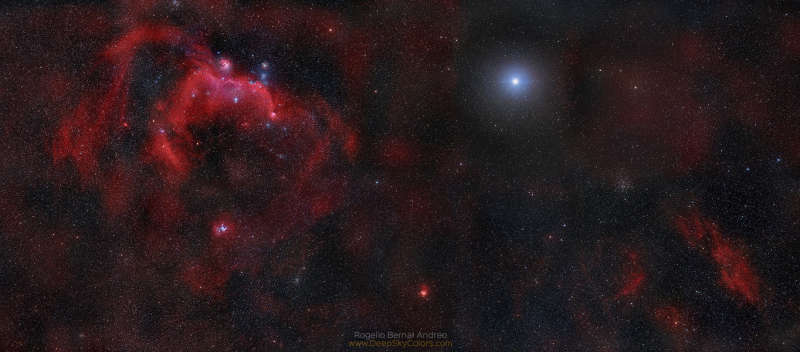Credit & Copyright: Rogelio Bernal
Andreo (Deep Sky Colors)
Explanation:
This broad, beautiful mosaic spans almost 20 degrees across
planet Earth's sky.
The nebula-rich
region lies near the edge of the Orion-Eridanus
supperbubble, filled with looping, expanding shells of gas and dust embedded
in molecular clouds near the plane of the Milky Way Galaxy.
Recognizable at the left is the expansive
Seagull Nebula,
composed of emission nebula NGC 2327, seen as the seagull's head,
with the more
diffuse IC 2177 as the wings and body.
Some 3,800 light-years away, the wings of the Seagull Nebula
spread about 240 light-years, still within our
local spiral arm.
The bluish light of
Sirius,
alpha star of Canis Major and
brightest star in the night, easily dominates the scene at right
but shines from a distance of only 8.6 light-years.
Study the big picture and you should
also be rewarded with star cluster
Messier 41,
also known as NGC 2287, not to
mention the mighty Thor's Helmet.
1999 2000 2001 2002 2003 2004 2005 2006 2007 2008 2009 2010 2011 2012 2013 2014 2015 2016 2017 2018 2019 2020 2021 2022 2023 2024 2025 |
Yanvar' Fevral' Mart Aprel' Mai Iyun' Iyul' Avgust Sentyabr' Oktyabr' Noyabr' Dekabr' |
NASA Web Site Statements, Warnings, and Disclaimers
NASA Official: Jay Norris. Specific rights apply.
A service of: LHEA at NASA / GSFC
& Michigan Tech. U.
|
Publikacii s klyuchevymi slovami:
Sirius - emission nebula - Sirius - emissionnaya tumannost'
Publikacii so slovami: Sirius - emission nebula - Sirius - emissionnaya tumannost' | |
Sm. takzhe:
Vse publikacii na tu zhe temu >> | |
